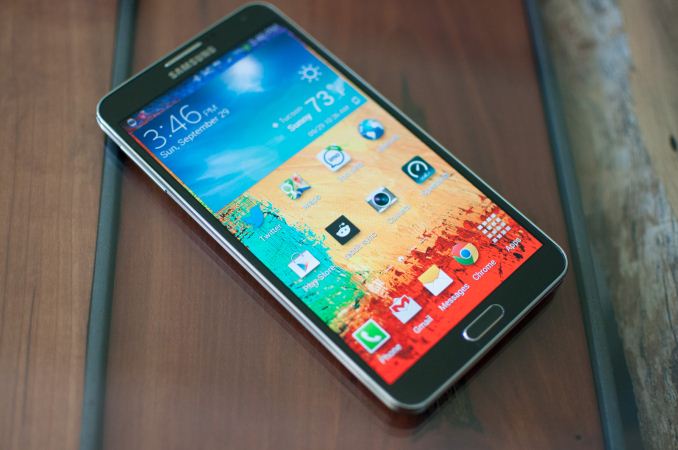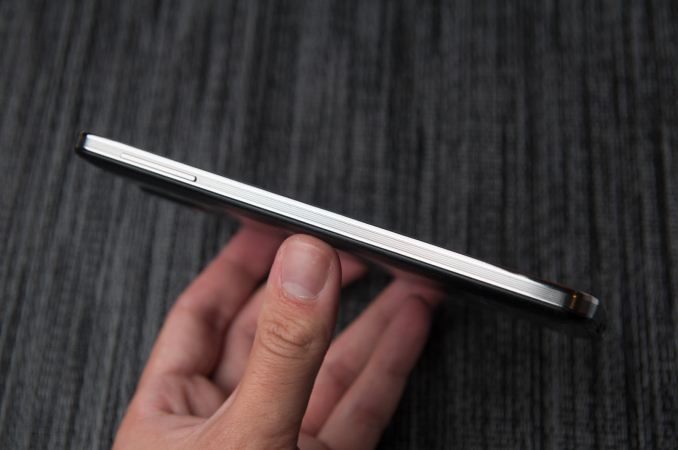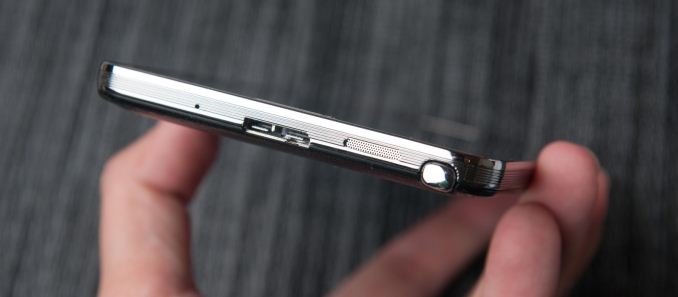Samsung Galaxy Note 3 Review
by Brian Klug on October 1, 2013 9:00 AM EST- Posted in
- Smartphones
- Samsung
- Mobile
- Android 4.3
- galaxy note 3

I still remember the first time I held the original Galaxy Note. At that point in time it wasn’t really obvious just how critical larger-display smartphones were going to be in the future, nor just how close the smartphone market was to becoming a mature one. In a mature market it’s all about filling in the niches, something Samsung has been doing since the very beginning by casting a very large form factor net with its lineup of android devices.
I remember being intrigued with the original Note more for the active digitizer feature (S-Pen) than the large display. It was during the height of the draw something craze, and having a stylus seemed like a logical advantage. Two years I lean the other way entirely, it’s that bigger display that makes me interested in the form factor not just as a curiosity but as something I actually want to use daily.
This is now Samsung’s third Galaxy Note, and as the adage goes hopefully third time is indeed a charm. Not that the first two weren’t wildly popular to begin with, either.
The Note 3 is obviously an iterative product with iterative improvements. The basic formula of the Note is unchanged - huge display, bumped specs versus the S series flagship, and active digitizer pen. The improvements this time are bigger display while making the overall device dimensions smaller, much faster SoC, higher resolution display, better camera, and all the improvements around the edges you’d expect (802.11ac, USB 3.0, IR).
I always start out by talking about the industrial design, appearance, and feel of devices, and won’t change that with the Note 3. Let’s just say it - the design of the Note 3 honestly isn’t a significant departure from Samsung’s norm. Then again nobody should’ve expected a huge departure to begin with.
Whereas the Note 2 felt and looked a lot like a blown up SGS3, the Note 3 is likewise a bit like a larger SGS4, although I honestly see bits of SGS2 in it. The front is home to the huge display, the same kind of earpiece grille we always see from Samsung, front facing camera, physical home button, and capacitive menu and back buttons.
The edge of the Note 3 is ringed with the familiar chrome, although this time there’s a ridge which makes it more grippy. With bigger phones making the edges less slippery is important, the Note 3 hits the mark here nicely.
All the buttons are also in the usual places for Samsung, and feel great. Power is easy to get to, the volume rocker as well is nicely positioned.
Headphone jack and the IR port are up top, along with one of the 3 microphones used for noise cancelation on the Note 3.
There’s another microphone on the bottom right of the device, and the third is at the bottom to the left of the microUSB 3.0 type B connector jack.
There’s been a lot of talk about the presence of USB 3.0, even though the micro B connector type has been around for considerable time already and in a ton of devices. The Note 3 just has the misfortune of apparently being many people’s first exposure to the connector, whose awkward double lobed shape gives it forwards compatibility with microUSB 2.0. The rightmost region is just the familiar microUSB 2.0 connector, the left contains the pins for SuperSpeed signaling for 3.0. Plug something into the right 2.0 jack and you get 2.0 speed for transfers and charging. 3.0 at present should give you faster transfer rate (it doesn't in practice as you'll soon see), and eventually faster charging, but the Note 3 continues to use Samsung’s 2.0 amp charging spec and rate, but more on that later.
|
Samsung Galaxy Note 3 (T-Mobile SM-N900T) |
|
| SoC |
2.3 GHz Qualcomm Snapdragon 800 (MSM8974) 4x Krait 400 @ 2.3 GHz, Adreno 330 at 450 MHz |
| Display | 5.7-inch Super AMOLED (1080p) |
| RAM | 3 GB LPDDR3 |
| WiFi | 802.11a/b/g/n/ac (BCM4339) + BT 4.0 |
| Storage | 32 / 64 GB + microSDXC (up to 64 GB) |
| I/O | microUSB 3.0, MHL 2.0, IR LED (remote), NFC |
| OS | Android 4.3 |
| Battery | 3200 mAh, 3.8V, 12.1 Whr |
| Size / Mass | 151.2 x 79.2 x 8.3mm, 168g |
| Camera |
13 MP w/AF, LED (Rear Facing) – 1080p60, 720p120, 4k30 2 MP (Front Facing) |
Whereas most of the Note 3 is par for the course for Samsung device design, the backside is something different entirely. Instead of the slick plastic that we normally get out of the Korean handset makers, the Note 3 backside material is plastic, textured to look like a leather bound book complete with faux stitching, and in the case of the black color, topped with a somewhat grippy rubbery finish. The white model doesn’t get that rubbery finish, and instead just feels like somewhat roughly textured plastic with the same faux leather pattern. I’ve held pleather, fake leather, and real leather, and this frankly isn’t any of that. It’s still injection molded plastic, but this time patterned so it looks vaguely leather.
Samsung does deserve kudos for not just giving us another slimy-backed phone with a glossy plastic battery cover, however. I have to admit I do like the rubber finish on the black Note 3 I was sampled, as the white one feels significantly different as it lacks that finish. The only downside is that it does pick up and show hand grease, whereas the white one handles it better. I could do without the fake stitching though.
I’ve been avoiding the discussion about the size of the Note 3 and whether it’s too big or too much. I’ve addressed this before in the Note 2 review, and I’d encourage you to read page 2’s “using a phablet” section, since the Note 3 is essentially the same situation, since it’s the same form factor. I can definitely use the form factor just fine, and the Note 3 comfortably. With the swipe keyboards that are popular now (I just use the stock Google Keyboard) I can even type one handed without much effort. In fact I’ve written a huge chunk of this review on the Note 3 in Draft, some of it one-handed.
Hands vary in size, and what size device is “best” for someone is really just a matter of personal taste. Some people are clamoring for smaller devices, others want bigger - as this market matures, success for OEMs will mean a diverse portfolio filling in all the obvious form factors.
More and more I’m starting to think the width of devices is the pain point that causes real fatigue, and edge bezel thickness. The Note 3 does very well here compared to its predecessor because it’s thinner, and lighter. In fact, you could pretty much sum up the Note 3 with – thinner, lighter, faster, oh and it has a bigger display at the same time.
|
Galaxy Note 3 (T-Mobile) |
Galaxy Note 2 (T-Mobile) |
Galaxy Note (AT&T) |
|
| Height | 151.2 mm | 151.1 mm | 146.85 mm |
| Width | 79.2 mm | 80.5 mm | 82.95 mm |
| Thickness | 8.3 mm | 9.4 mm | 9.65 mm |
| Mass | 168 grams | 180 grams | 178 grams |
| Display Size | 5.7-inch | 5.5-inches | 5.3-inches |
| Display Resolution | 1920 x 1080 | 1280 x 720 | 1280 x 800 |
| SoC | 2.3 GHz Snapdragon 800 (4x Krait 400) | 1.6 GHz Samsung Exynos 4412 (4x Cortex A9) |
1.4 GHz Qualcomm Snapdragon (APQ8060 - 2x Scorpion) |
| Camera | 13 MP with LED | 8 MP with LED | 8 MP with LED |
| Battery | 3200 mAh, 3.8V, 12.16 Whr | 3100 mAh, 3.8V, 11.78 Whr | 2500 mAh, 3.7V, 9.25 Whr |
I really want to use the Note 3 a lot more this time, since having more display real estate does make me feel like I can accomplish more. Obviously multimedia content also benefits from a larger viewport as well. Since I haven’t ever really been a tablet person, larger phones seem like a logical tradeoff.
Honestly the Note 3 feels better than its predecessor, and the biggest reasons for that are the textured rubberized back, grippier textured edge, thinner body, and thinner width. Oh and there’s no creakiness or build quality issues to speak of, in spite of being so large the Note 3 is very rigid and solid.




















302 Comments
View All Comments
Spunjji - Tuesday, October 8, 2013 - link
Says you.kapg - Wednesday, October 2, 2013 - link
I really respect Anandtech and consider it to be the top benchmark for all tech related stuff.That said I am not sure of a couple of the following things and would really appreciate if someone can please throw some light on these to help me understand these better:
- Browsing benchmarks like Sunspider Javascript Benchmark 1.0, Google Octane Benchmark v1, Mozilla Kraken Benchmark – 1.1 & Browsermark 2.0...are these dependenton/affected by the screen resolution, if so then should they not be run on the same resolution for different devices to provide an ideal representation of the CPU??
- Why is it that all benchmarks that Anantech runs are not run with the same set of devices, some benchmarks are with a certain set and with other benchmarks devices are added. I can understand that not all devices support the same set of benchmark tools but as that is the case should we not test only on those benchmarks that are common to all devices (or on which all devices can be made to run/simulated).....this is just coz it is pretty confusing for a non-expert as me to compare two devices (say Apple iPhone 5s vs Nokia 925 vs Samsung S4)
Am sorry if these querries are noobish as I do not understand the in-depth details of these benchmarks and hope someone can clarify.
peace,
~kg
thunng8 - Wednesday, October 2, 2013 - link
JavaScript and browser benchmarks are not dependent on screen resolutionSamunosuke - Wednesday, October 2, 2013 - link
In the pc world, if it was discovered that Sager's GT780m consistently benched higher than equivalent Alienware/MSI/Asus etc 780m but yet performed the same in games, what would be the reaction? I was surprised when the galaxy s4's benchmark boost was glossed over just because some of samsung's apps were included. That doesn't make it acceptable. The cpu/gpu is a known factor and should be the same for all apps regardless of origin or use. Boosting benchmarks is wrong, plain and simple. All manufacturers who do it should be called out. There are several ways to curb this:1. Do what arstechnica did and circumvent the benchmark boost by renaming the benchmark software (you can keep that and use on all devices from here on out and updating when necessary).
2. Run battery life tests in the boosted state (by renaming the browser/media player/whatever you use to run the battery life tests to a boosted app).
Its not fair if other devices either have lower battery life due to increased performance or higher battery life due to reduced performance and yet others find a way to inflate their scores and get the best of both worlds.
kapg - Wednesday, October 2, 2013 - link
"2. Run battery life tests in the boosted state (by renaming the browser/media player/whatever you use to run the battery life tests to a boosted app)."I do not agree with running battery life test in the boosted state as that is not the regular mode in which any of those apps will function and thus the results obtained will not be realistic. In my view battery tests should be run with the device(s) in standard state and having the same set of apps across all devices and the same activity being performed (in a loop if needed) across all devices.
peace,
~kg
Origin64 - Wednesday, October 2, 2013 - link
Sitting here looking at my SGS (1) all I can think is how little has changed in over 3 years. Screens got a little bigger, resolutions went up, so did the prices, but functionality is just the same as it ever was. Really disappointing, but I guess I can blame the extremely limited data plans for that. Bandwidth-intensive mobile applications cost a lot to use, so we're not even doing half of what our mobile computing could do.Good news is that there's still no incentive to upgrade whatsoever. I can wait a second or 2 for an app to open, and I can spend time opening apps because I dont have to work long hours to spend 600 dollars a year on a phone. See how that all comes back together?
Kathrine647 - Wednesday, October 2, 2013 - link
like Gregory said I am alarmed that a stay at home mom able to earn $5886 in 1 month on the internet. visit their website............Kathrine647 - Wednesday, October 2, 2013 - link
like Gregory said I am alarmed that a stay at home mom able to earn $5886 in 1 month on the internet. visit their website............B u z z 5 5 . comKathrine647 - Wednesday, October 2, 2013 - link
like Gregory said I am alarmed that a stay at home mom able to earn $5886 in 1 month on the internet. visit their website............B u z z 5 5 . com open the link without spaceszoob - Wednesday, October 2, 2013 - link
Am I missing something? I see a paragraph describing the IR port and headphone jack, but I do not see an accompanying photo.